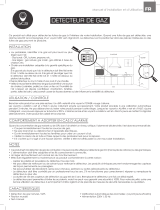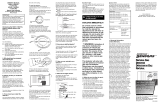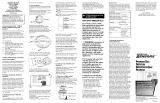
6
CAUTION Installing the 15 Amp fuse could cause the
engine to start at any time without warning resulting in
minor or moderate injury.
• Observe that the 15 Amp fuse has been removed from the
control panel for shipping.
• DO NOT install this fuse until all plumbing and wiring has been
completed and inspected.
CAUTION Excessively high operating speeds could result
in minor injury.
Excessively low speeds impose a heavy load on generator.
• DO NOT tamper with governed speed. Generator supplies
correct rated frequency and voltage when running at governed
speed.
• DO NOT modify generator in any way.
NOTICE Improper treatment of generator could damage it and
shorten its life.
• Use generator only for intended uses.
• If you have questions about intended use, contact your
authorized dealer.
• Operate generator only on level surfaces.
• Adequate, unobstructed flow of cooling and ventilating air is
critical for correct generator operation.
• The access panels/door must be installed whenever the unit
is running.
• DO NOT expose generator to excessive moisture, dust, dirt, or
corrosive vapors.
• Remain alert at all times while working on this equipment.
Never work on the equipment when you are physically or
mentally fatigued.
• DO NOT start engine with air cleaner or air cleaner
cover removed.
• DO NOT insert any objects through cooling slots.
• DO NOT use the generator or any of its parts as a step.
Stepping on the unit could cause stress and break parts. This
may result in dangerous operating conditions from leaking
exhaust gases, fuel leakage, oil leakage, etc.
• If connected devices overheat, turn them off and disconnect
them from generator.
• Shut off generator if:
-electrical output is lost;
-equipment sparks, smokes, or emits flames;
-unit vibrates excessively.
-unit makes unusual noises.
WARNING Exhaust heat/gases could ignite combustibles
or structures resulting in death or serious injury.
Contact with muffler area could cause burns
resulting in serious injury.
• DO NOT touch hot parts and AVOID hot exhaust gases.
• Allow equipment to cool before touching.
• Exhaust outlet side of weatherproof enclosure must have at
least 5 ft (1.5 m) minimum clearance from any structure, shrubs,
trees or any kind of vegetation.
• Standby generator weatherproof enclosure must be at least 5
ft from windows, doors, any wall opening, shrubs or vegetation
over 12 inches (30.48 cm) in height.
• Standby generator weatherproof enclosure must have a
minimum of 5 ft (1.5 m) overhead clearance from any structure,
overhang or trees.
• DO NOT place weatherproof enclosure under a deck or other
type of structure that may confine airflow.
• USE ONLY flexible steel fuel line provided. Connect provided
fuel line to generator, DO NOT use with or substitute any other
flexible fuel line.
• Smoke detector(s) MUST be installed and maintained indoors
according to the manufacturer’s instructions/ recommendations.
Carbon monoxide alarms cannot detect smoke.
• Keep at least minimum distances shown in Generator
Placement to insure for proper generator cooling and
maintenance clearances.
• It is a violation of California Public Resource Code, Section
4442, to use or operate the engine on any forest-covered,
brush-covered, or grass-covered land unless the exhaust
system is equipped with a spark arrester, as defined in Section
4442, maintained in effective working order. Other states or
federal jurisdictions may have similar laws.
Contact the original equipment manufacturer, retailer, or
dealer to obtain a spark arrester designed for the exhaust
system installed on this engine.
• Replacement parts must be the same and installed in the
same position as the original parts.
WARNING Starter and other rotating parts could entangle
hands, hair, clothing, or accessories resulting in
serious injury.
• NEVER operate generator without protective housings, covers,
or guards in place.
• DO NOT wear loose clothing, jewelry or anything that could be
caught in the starter or other rotating parts.
• Tie up long hair and remove jewelry.
• Before servicing, remove 15 Amp fuse from control panel and
disconnect Negative (NEG or -) battery cable.






















